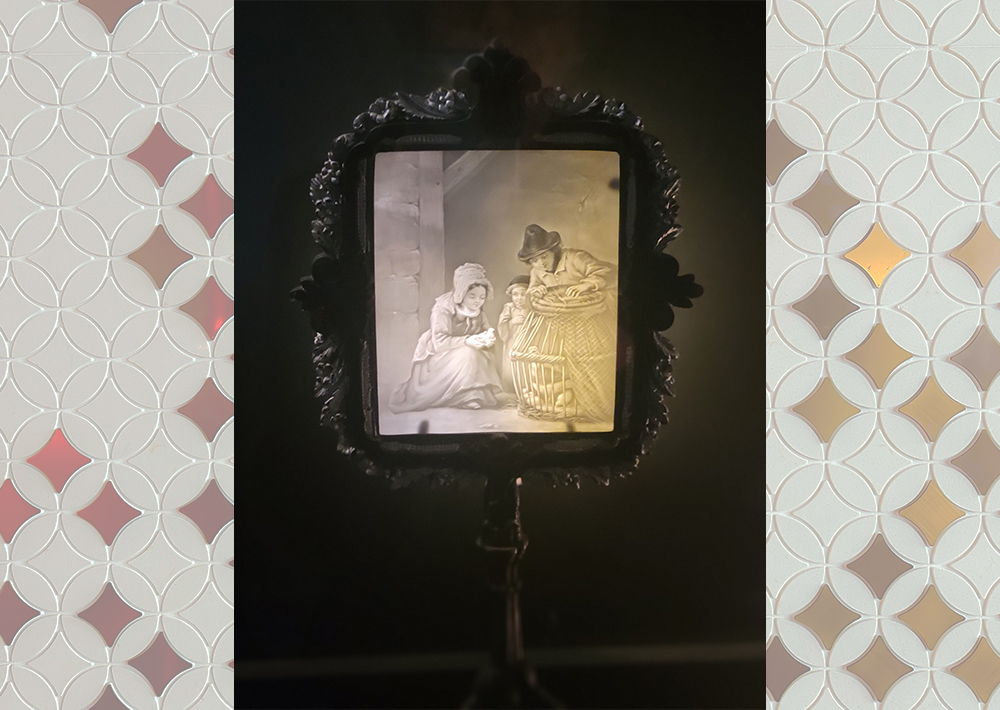
[Image above] Example of a lithophane in the Blair Museum of Lithophanes collection. Credit: (Photo) Laurel Sheppard; (Background) Standish Thamrin, Shutterstock
In the small village of Elmore, Ohio, sits the Blair Museum of Lithophanes on the beautiful grounds of the Schedel Arboretum and Gardens. The museum has the world’s largest collection of this 19th century art form, with nearly 3,000 pieces, and is the only institution dedicated entirely to lithophanes.
The term lithophane, which is derived from the Greek words litho (stone) and phainen (to cause to appear), is a 3D translucent porcelain plaque that is backlit to reveal detailed images. These plaques, which can be rectangular, square, oval, circular, or trapezoidal, are used as candle shields, table screens, shades, and night lights, among other applications.
The genesis of the lithophane museum started with a Toledo man named Laurel Gotshall Blair (first time I heard of a male with my first name!). He first discovered lithophanes in 1961 while attending a meeting of collectors from the International Music Box Society. Several years later, Blair opened a private museum in his Toledo home to showcase his growing collection.
Blair continued collecting lithophanes from around the world over the next several decades. After his death in 1993, his large collection was donated to the City of Toledo, where it was later displayed at the Toledo Botanical Gardens. In 2020, the city gave the Blair collection to the Schedel Foundation.
ACerS Fellow Margaret Carney was hired as the Blair Museum’s first curator in 2004. The experience inspired her to write a short article for Ceramics Monthly in 2007 and then publish a full book on lithophanes in 2008.
I was fortunate to see part of the collection in person when I visited Elmore this October with a friend. The museum was showcasing a new exhibit called Flora & Fauna of Europe in the Early 1800s, which highlighted the “integral role that nature and the surrounding environment played in the lives of people from long ago.” (See video below for some examples.)
Because the museum is small, it can only hold a fraction of the total collection and is kept in relative darkness so you can better appreciate the beautiful lithophanes. But even from these few examples, I gained a greater understanding of how lithophanes have evolved over time, with the latest wave of renewed interest in this art form being due to the novel fabrication method of 3D printing.

Credit: The American Ceramic Society, YouTube
History and traditional fabrication of lithophanes
While there are examples of early Chinese potters decorating eggshell-thin porcelain vases with intricate patterns, lithophanes as we know them today are a European invention. French diplomat Baron Paul de Bourgoin is generally credited as inventing the modern fabrication process, which he patented in 1827. The process involved the following steps:
- An intricate design is carved into beeswax using small tools.
- A mold, either open face or in two parts, is made of the wax carving.
- A porcelain paste or slip is then pressed or poured into the mold and cured.
- The lithophane is fired in a kiln at 2,000°F (which causes it to shrink about 20%).
The art form spread throughout Europe as manufacturers adopted the French method. But by the end of the 19th century, lithophanes were no longer as popular. The 20th century saw a few applications: commemorative mugs in honor of King Edward VII’s coronation in 1902; and after WWII, cups with a lithophane geisha face on the bottom were mass produced by Japanese companies and marketed to U.S. soldiers.
Modern lithophanes
Porcelain lithophanes are still made by both small potteries and large manufacturers. But the manufacture of lithophanes has also entered the 21st century, with 3D printing using plastic or resin now being a common method. (Computer numerical control machining methods have also been used, but these techniques require more labor and higher material cost than 3D printing.)
Photographs are often used to inspire lithophane design, but these 2D images need to be converted into a 3D model first. Typically, a grayscale image with high contrast is used for best results. Lighter areas in the photo indicate thinner areas in the porcelain, so the lithophane appears brighter, and darker areas in the photo indicate thicker areas, which will appear darker because less light can get through.
Software exists for converting photographs into the 3D models needed to make 3D-printed lithophanes. Because this technology makes it easy to create lithophanes at home, personalized gifts have become popular, such as illuminated displays of photos of pets or loved ones.
Learn more about how additive manufacturing is being used to create personalized lithophanes, and watch how the world’s longest 3D-printed lithophane (4 feet or 1.2 meters long) featuring a Chinese dragon was made here. You can also read this past CTT to discover how lithophanes can make the scientific literature more accessible!
Author
Laurel Sheppard
CTT Categories
- Art & Archaeology
- Education


